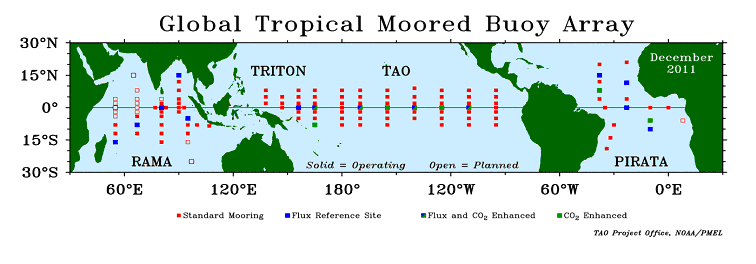- El Niño/Southern Oscillation (ENSO) in the Pacific
- The inter-hemispheric dipole mode, equatorial warm events, and hurricane activity in the Atlantic
- The monsoons, the Indian Ocean Dipole, and intra-seasonal variability in the Indian Ocean
 Development of the Tropical Atmosphere Ocean (TAO) array of moored buoys in the tropical Pacific was motivated by the 1982-1983 El Nino event and developed by the Pacific Marine Environmental Laboratory (PMEL) under NOAA's Equatorial Pacific Ocean Climate Studies (EPOCS) program. The array has been extended to the west and into the Indian Ocean with the deployment of the Triton array implemented by the Japan Marine Science and Technology Center (JAMSTEC). The TAO and TRITON arrays combined in January 2000 to recognize the introduction of TRITON buoys in the western Pacific by JAMSTEC. The Atlantic array, PIRATA, is a joint project of France (ORSTOM), Brazil (INPE and DHN), and the USA (PMEL/NOAA).
Development of the Tropical Atmosphere Ocean (TAO) array of moored buoys in the tropical Pacific was motivated by the 1982-1983 El Nino event and developed by the Pacific Marine Environmental Laboratory (PMEL) under NOAA's Equatorial Pacific Ocean Climate Studies (EPOCS) program. The array has been extended to the west and into the Indian Ocean with the deployment of the Triton array implemented by the Japan Marine Science and Technology Center (JAMSTEC). The TAO and TRITON arrays combined in January 2000 to recognize the introduction of TRITON buoys in the western Pacific by JAMSTEC. The Atlantic array, PIRATA, is a joint project of France (ORSTOM), Brazil (INPE and DHN), and the USA (PMEL/NOAA).RDSEA Awarded New Contract with the NOAA
